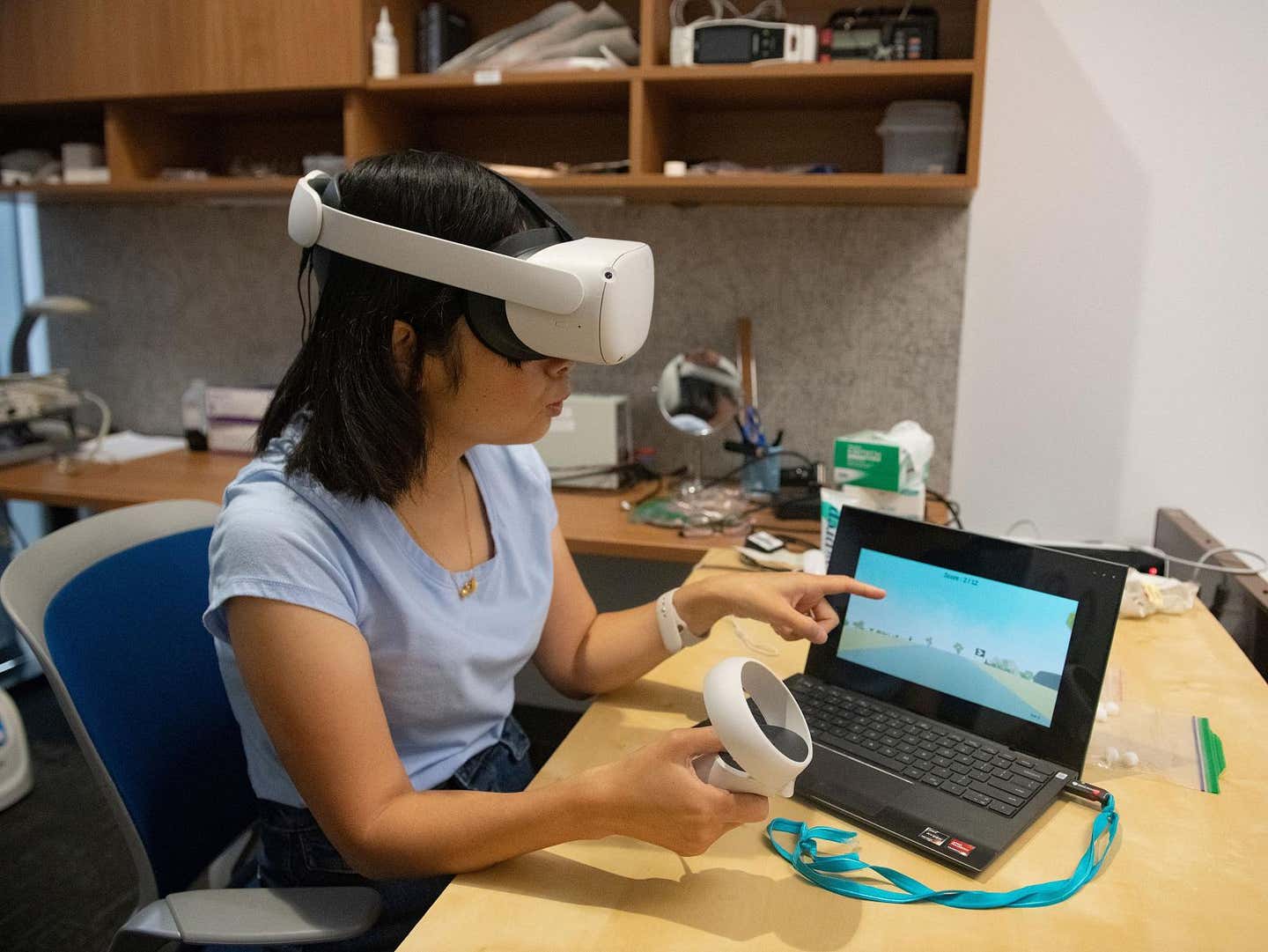Scientists Revolutionize Virtual Reality with Brain-Monitoring Capabilities
Researchers have unveiled a sophisticated modification to a commercial VR headset that could redefine neurology and virtual reality.

[Aug. 6, 2023: Staff Writer, The Brighter Side of News]
Hongbian Li, a research associate in professor Nanshu Lu's lab. (CREDIT: The University of Texas at Austin / Cockrell School of Engineering)
In a groundbreaking venture that may potentially redefine the intersection between neurology and virtual reality (VR), researchers from The University of Texas at Austin have unveiled a sophisticated modification to a commercial VR headset. This new innovation not only offers an immersive VR experience but also simultaneously measures the brain's electrical activity.
This pioneering endeavor sees the seamless integration of a noninvasive electroencephalogram (EEG) sensor into a Meta VR headset.
With the headset comfortably equipped, users can immerse themselves in VR scenarios for extended durations while the device documents the brain's electrical reactions to the stimuli. Such an integration offers countless applications, spanning from therapeutic approaches for anxiety sufferers to assessing the mental strain of pilots in flight simulations, even allowing humans to visualize the world through a robot's eyes.
Nanshu Lu, the spearhead behind the project and a professor in the Cockrell School of Engineering's Department of Aerospace Engineering and Engineering Mechanics, opined, "Virtual reality is so much more immersive than just doing something on a big screen. It gives the user a more realistic experience, and our technology enables us to get better measurements of how the brain is reacting to that environment."
Related Stories
The Edge Over Contemporary Devices
While the union of VR and EEG isn't novel in the commercial world, present devices come with a hefty price tag. The team at UT Austin has emphasized that their innovation not only mitigates cost but also offers users a far more comfortable experience. This would invariably lead to prolonged wearing durations, which in turn amplifies potential applications.
Most contemporary EEG apparatuses involve wearing a cap strewn with electrodes. However, these don't gel well with VR headsets. Plus, the effectiveness of individual electrodes diminishes as they grapple to establish a solid connection due to the barrier posed by human hair. The commonly used rigid and comb-like electrodes penetrate through the hair, often proving uncomfortable for users.
"All of these mainstream options have significant flaws that we tried to overcome with our system," highlighted Hongbian Li, an integral member of Lu's research cohort. As a resolution, the team innovated a pliable electrode fabricated from soft, conductive materials, leading the charge to bypass the aforementioned challenges.
The installed noninvasive electroencephalogram (EEG) sensor electrode, used to measure the brain’s electrical activity during immersive VR interactions. (CREDIT: The University of Texas at Austin / Cockrell School of Engineering)
This reimagined headset boasts electrodes positioned along the top strap and forehead pad, is fortified with a malleable circuit similar to Lu's electronic tattoos, and comes equipped with an EEG recording mechanism at its rear.
An Insight into the Future: Robots and Humans
This groundbreaking technology dovetails another major research initiative at UT Austin. This ambitious project involves a robot delivery network, set to be the most extensive study probing human-robot interaction to date.
Design of our VR-EEG headset. A schematic illustration of the PMA sponge electrodes integrated on a commercial VR headset to make good contact with the hairy scalp for EEG. The blue dash lines labeled on the VR headset strap indicate the outline of the FCA laminated on the other side of the strap. (CREDIT: Soft Science)
Lu, who also plays a pivotal role in this initiative, shared that the VR headsets would serve a dual purpose. They would be employed by individuals either accompanying robots or stationed in a distant observatory. Here, individuals can view events from the robot's vantage point. Concurrently, the device evaluates the cognitive load borne by these observers over extended periods.
Offering his perspective, Luis Sentis, another influential figure in the Department of Aerospace Engineering and Engineering Mechanics and a contributor to the VR EEG research, stated, "If you can see through the eyes of the robot, it paints a clearer picture of how people are reacting to it and lets operators monitor their safety in case of potential accidents."
Fabrication, microstructure, and mechanical characterization of the PMA sponge electrode. Schematic illustrations of the PMA sponge fabrication process. (CREDIT: Soft Science)
Test Drives and Future Endeavors
To gauge the efficacy of this VR EEG headset, the team devised a game. Collaborating with José del R. Millán, an authority on brain-machine interfaces from the Chandra Family Department of Electrical and Computer Engineering and the Dell Medical School, they fashioned a driving simulation. Here, participants would respond to turn commands with a button press.
During this simulation, the EEG meticulously documented the participants' brain activity, allowing researchers to determine their level of attentiveness.
As a testament to their confidence in this game-changing innovation, the researchers have already initiated preliminary patent procedures. They have also expressed keen interest in joining forces with established VR corporations to embed their technology into mainstream devices.
Contact impedance of the sponge electrode on hairless skin (A-C) and hairy skin (D-F). (A) Cross-sectional schematic and equivalent circuit model of the sponge electrode on hairless skin. (CREDIT: Soft Science)
This research is documented in detail in the journal Soft Science. As the lines between the physical and virtual worlds continue to blur, initiatives such as these indicate a future where our very brainwaves could interact and mold our digital experiences.
Other members of the research team include Hyonyoung Shin, Minsu Zhang, Nicholas Riveira and Susmita Gangopadahyay of the Chandra Family Department of Electrical and Computer Engineering; Andrew Yu, Heeyong Huh, Zhengjie Li, and Yifan Rao from the Department of Aerospace Engineering and Engineering Mechanics; Sangjun Kim from the Walker Department of Mechanical Engineering, Jessie Peng of the Department of Biomedical Engineering; and Gubeum Kwon of Artue Associates Inc. in South Korea.
For more science stories check out our New Discoveries section at The Brighter Side of News.
Note: Materials provided above by The Brighter Side of News. Content may be edited for style and length.
Like these kind of feel good stories? Get the Brighter Side of News' newsletter.
Joseph Shavit
Head Science News Writer | Communicating Innovation & Discovery
Based in Los Angeles, Joseph Shavit is an accomplished science journalist, head science news writer and co-founder at The Brighter Side of News, where he translates cutting-edge discoveries into compelling stories for a broad audience. With a strong background spanning science, business, product management, media leadership, and entrepreneurship, Joseph brings a unique perspective to science communication. His expertise allows him to uncover the intersection of technological advancements and market potential, shedding light on how groundbreaking research evolves into transformative products and industries.



